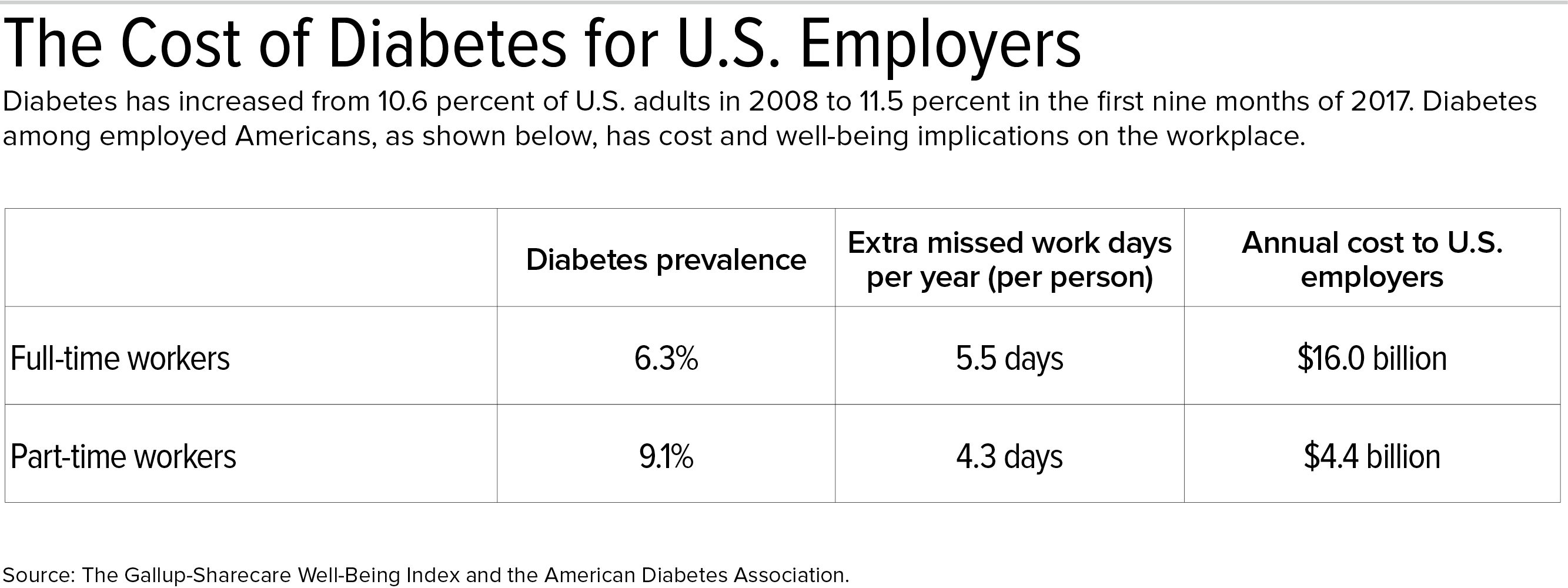Rising Diabetes Rates Are Costly for Employers
Lifestyle-management programs can help people with, or at risk of developing, Type 2 diabetes

Type 2 diabetes, characterized by high blood sugar and insulin resistance, and linked to unhealthy diets and a lack of regular exercise, is increasing among U.S. adults. That translates into high costs for employers—more than $20 billion annually due to unplanned, missed days of work.
The Cost of Diabetes in the U.S.: Economic and Well-Being Impact, a new report by Gallup researchers and Sharecare, a health and wellness engagement firm, was released to coincide with World Diabetes Day on Nov. 14.
November is also recognized by the Centers for Disease Control and Prevention, among others, as National Diabetes Month, a time for promoting awareness about managing diabetes.
(Click on graphic to view in a separate window.)
Being obese (severely overweight) is a leading risk factor for developing diabetes, the report noted. People with diabetes have much higher rates of other chronic disease such as high blood pressure, high cholesterol, heart attack and depression, and they are less likely to get regular exercise or engage in other healthy behaviors.
The findings are based on a subset of 354,473 telephone interviews with U.S. adults across all 50 states and the District of Columbia, conducted from January 2015 through December 2016 as part of the Gallup-Sharecare Well-Being Index. Diabetes cost analysis findings were drawn from research by the American Diabetes Association.
"While most clinicians agree that managing diabetes improves health and reduces medical costs, the benefit to employers also extends to a more productive workforce," said Sharecare Vice President Sheila Holcomb. "An opportunity exists for employers to partner with the medical community, specifically certified diabetes educators at local and regional hospitals, to offer diabetes education and training to their employees."
Helping employees to keep their blood glucose within an appropriate range can have "tangible and proven value for both the individual and the company's bottom line," she said.
[SHRM members-only toolkit: Designing and Managing Wellness Programs]
Weight Management and Exercise
For World Diabetes Day, the personal finance website WalletHub produced a Diabetes Facts & Statistics infographic, drawing on data from the American Diabetes Association, the National Institutes of Health, the Centers for Disease Control and Prevention, and others. Among the numbers:
- 90 percent of Americans with Type 2 diabetes are overweight or obese.
- There is a 26 percent decrease in the risk of diabetes among those who get 2.5 hours of exercise each week.
"As the prevalence of diabetes rises, its impact strikes at the vitality of everyday life," said Steven Edelman, founder and director of the nonprofit organization Taking Control of Your Diabetes. Employers in collaboration with health care providers can make available "lifestyle management programs and education specifically targeted at [those with] diabetes and prediabetes."
Related SHRM Articles:
Defusing the Diabetes Workforce 'Time Bomb', SHRM Online Benefits, February 2014
HR Technology: Help Employees Get Healthy, HR Magazine, July 2013
Managing Diabetes: Incentives and 'Coaches' Improve Health, Lower Costs, SHRM Online Benefits, May 2009
Was this article useful? SHRM offers thousands of tools, templates and other exclusive member benefits, including compliance updates, sample policies, HR expert advice, education discounts, a growing online member community and much more. Join/Renew Now and let SHRM help you work smarter.
An organization run by AI is not a futuristic concept. Such technology is already a part of many workplaces and will continue to shape the labor market and HR. Here's how employers and employees can successfully manage generative AI and other AI-powered systems.




